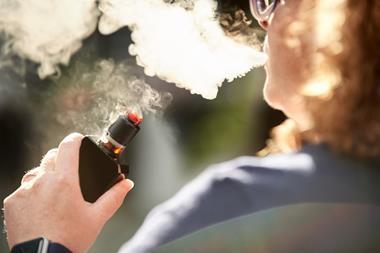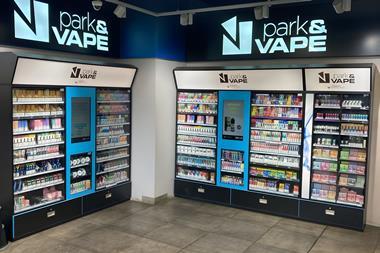It’s been another challenging year for the tobacco industry as the legislative pressures pile on, but the category continues to do well and not least on forecourts.
Despite the much publicised plans to ban smoking in public places, more than 13 million adults – around 30% of the adult population – continue to smoke and they spent more than £12.6bn on their preferred tobacco brands in the year ending June 2005.
Forecourts have once again held their own, taking a 12.1% share of cigarette sales, worth £1.35bn. According to research by IGD, the average weekly cash profit on tobacco for each UK forecourt is around £400. After petrol, tobacco is the biggest cash generator for forecourts and delivers bigger gross profits than milk, newspapers and fast food added together.
Tobacco is also a huge footfall driver, but retailers spend the majority of the time with their backs to the display, so it’s worth turning around every now and then and giving the section the attention it deserves.
Iain Watkins, trade communications manager at Imperial Tobacco, says: “The impulse purchases generated by tobacco are not to be underestimated. Smokers spend 68% more per visit than non-smokers, so they’re worth that much more to you if you can keep them as regular customers by providing the brands that they prefer.”
Availability is crucial – tobacco consumers are very brand loyal and will walk away if their brand is out of stock. Mike Laney, national account manager for forecourts at Imperial Tobacco, says: “It’s been shown that if you’re out of stock of their brand twice, smokers will find somewhere else to buy it and they’ll take their basket spend – and with forecourts their £30-£40-worth of fuel – with them.”
Research carried out by HIM in spring 2005 found that the customer’s preferred brand and pack size was available at forecourts on average only 78% of the time – meaning that retailers had risked losing a significant chunk of trade.
While there are security implications to consider when keeping large stockholdings of tobacco, this shouldn’t become a barrier to keeping the gantry well-stocked. “Know what sells in your store and give it the extra facing that’s required so you don’t run out,” says Laney. “And if one person holds the key to the stock cupboard and they’re going to be away, then think about what brands are going to sell out within that time and have those fully stocked and maybe available under the counter so that they can be easily re-filled,” he adds.
It’s worth bearing in mind that every single person who comes into your shop and goes to a till – smoker or not – will see the tobacco display. If the tobacco gantry is well laid out and well stocked it creates a good impression of the whole store.
PREMIUM PROFITS
While the national cigarette market trend has continued to head towards lower-priced brands, on forecourts the premium sector is still the top performer, making up more than 40% of cigarette sales.
Jeremy Blackburn, trade communications manager for Gallaher, says: “The key for forecourts is the premium brands, which hold up very well compared to some other sectors. Higher sales of top quality products offer a bigger profit, so it is very important for forecourts to look after their premium sales.”
Blackburn suggests that one reason for this is that a lot of people use credit cards at forecourts and as such tend to be less price conscious. Research by HIM found that 62% of customers who buy tobacco in forecourts are male and they also tend to be more affluent than typical convenience store shoppers, with 70% in full-time jobs and 44% in the ABC1 demographic group.
However, while the premium brands are very important, the move towards cheaper brands should not be ignored as continuing government duty increases see smokers down-trade. Imperial’s Mike Laney says: “The market is changing, and it’s one of the things that forecourt operators need to be very aware of when they plan their range and how they merchandise their product. There is a shift towards the Lambert & Butlers and the Richmonds of this world.”
In the value-for-money sector, both Gallaher’s Mayfair brand and British American Tobacco’s Royals have recently had packaging re-vamps, aimed at taking advantage of this trend. Mayfair was in fact the fastest growing cigarette brand in the UK in 2004 and is a top-five seller on forecourts.
Aiming to bring back some of those premium cigarette smokers who have downtraded, Gallaher has launched its B&H brand in a new 14s pack size. Both the premium B&H Gold and the value-for-money B&H Silver, are available in 14s. Jeremy Blackburn says: “The new packs provide access to a premium product at an affordable price and appeal to purchasers of economy brands who would prefer a premium alternative. It’s attracted smokers back to the premium brands.”
Manufacturers say forecourt retailers should also be aware of the geographically diverse nature of the tobacco category to make sure they keep up-to-date with consumer trends. The best-selling brands will vary between regions, and if your site is on a commuter route or in an area that attracts holidaymakers from other parts of the country, you need to consider where these people are coming from and going to – so it’s important to talk to your customers.
ROLL YOUR OWN
While cigarettes account for more than 90% of a forecourt’s tobacco sales, the Roll Your Own (RYO) category continues to do well, with forecourts taking a 10.9% share of the total market.
Mike Laney, from Imperial Tobacco, says: “We’re seeing more dualists now, people who will smoke RYO during the course of the week and then switch to a branded factory-made cigarette at the weekend. There are also more female RYO smokers now – it used to be an older and more male dominated market but it’s become more socially acceptable.”
Gallaher’s Jeremy Blackburn recommends stocking rolling tobacco in more than one pack size: “Give people the option of the 25g pack. Make the most of the range and the fact that people are often prepared to spend a bit more in forecourt stores. People will up-weight their purchase – don’t let them buy 12.5g from you one day and another 12.5g pack from somewhere else a few days later.”
One of the key gains to be made from the growing RYO market is from the accessories that go with the tobacco, where there can be profit margins of 50%-plus to be made. The majority of people buying rolling tobacco will buy another product as well. This will usually be papers, but one in three RYO smokers also uses filter tips. Merchandising the various RYO products together will help prompt extra purchases.
Imperial’s Rizla remains the best-selling rolling paper brand and Rizla Regular Green the top product, however relative newcomers to the range, Rizla Regular Silver and Kingsize Slim Silver are at the premium end of the market and as such are particularly profitable.
In filter tips, Swedish Match dominates the market with the Swan brand. Available in a convenient Pop-a-Tip pack – instead of a loose box – the new format has been expanded this year to include Swan Slim Filters as well as Swan Extra Slim. Swedish Match has also been targeting 18-25 year-old students and first jobbers with its Styx rolling paper brand and Combi packs. Combi is another convenient format – it includes 50 papers and 50 Slim or Extra Slim filters in one pocket-sized flip-top box.
LAYING DOWN THE LAW
While the final details of the ban on smoking in public places in England continue to be debated – and debated some more – in Scotland a ban comes into force on March 26.
With tobacco consumers under increasing pressure to quit, how will this affect the market? Based on the Irish experience, where a public smoking ban was introduced in 2004, the evidence suggests that while sales in some licensed venues will drop, this will result in a chance to increase sales in other outlets.
Iain Watkins, from Imperial Tobacco, says: “We’ve noticed no detrimental effect on our sales, but there’s been a shift between the channels. Forecourts and c-stores have seen their shares of sales rise, while vending machines have lost out.”
Therefore, Scottish retailers should bear in mind that when the ban comes into effect there are likely to be smokers out there looking for somewhere new to buy from. The other expected outcome of any ban is that sales of take-home alcohol will be given a boost as consumers ditch the local pub in favour of more nights at home. “Retailers should realise that their channel could become a bit more important, because people will stop to get a bottle of wine and a packet of cigarettes and stay in. An opportunity is there,” says






























No comments yet